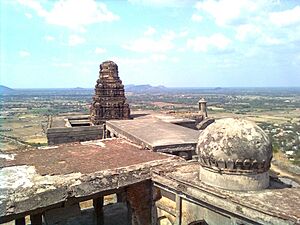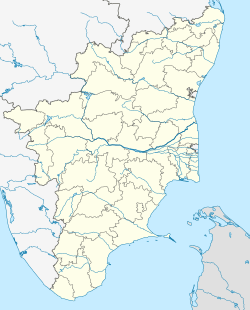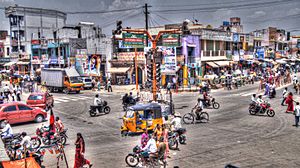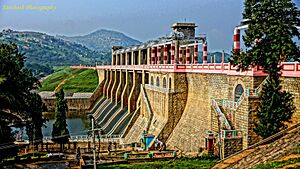Krishnagiri facts for kids
Quick facts for kids
Krishnagiri
Eyil Nadu, Murasu Nadu, Kowoor Nadu.
|
|
|---|---|
|
City
|
|

Remains of the ancient fort on the Krishnadevaraya Hill
|
|
| Country | |
| State | |
| District | Krishnagiri |
| Named for | Krishnadevaraya |
| Government | |
| • Type | Special Grade Municipality |
| • Body | Krishnagiri Municipality |
| Elevation | 525 m (1,722 ft) |
| Population
(2011)
|
|
| • Total | 199,657 |
| Languages | |
| • Official | Tamil |
| Time zone | UTC+5:30 (IST) |
| PIN |
635001,635002,635115,635101,635120
|
| Telephone code | 4343 |
| Vehicle registration | TN-24 |
Krishnagiri (IPA: [kiɾɯʂɳaɡiɾi]) is a city in the state of Tamil Nadu, India. It is the main office for the Krishnagiri District, which was created in 2004. The city sits at the base of the Krishnadevaraya Hills and is surrounded by rocky hills.
Krishnagiri is about 250 kilometers (155 miles) from Chennai, 45 kilometers (28 miles) from Dharmapuri, and 90 kilometers (56 miles) from Bengaluru. It is often called the "Mango Capital of India." This is because many mangoes are grown here. The land is very fertile and has plenty of fresh water, which is perfect for farming. The Krishnagiri Dam was built in 1967.
Contents
History of Krishnagiri
Ancient Times in Krishnagiri
The Krishnagiri area has a very old history. Scientists who study old things (archaeologists) have found proof that people lived here during the Paleolithic (Old Stone Age), Neolithic (New Stone Age), and Mesolithic Ages (Middle Stone Age).
Many rock paintings and carvings from the Indus Valley civilization and the Iron Age have been found in this district. These findings show how important this area has been throughout history.
Rulers and Modern History
The Krishnagiri region was once part of the ancient Kongu Nadu and the Chera kingdom. Chera rulers were the first to govern this area. Over time, many different empires and kingdoms ruled Krishnagiri. These included the Cholas, Pallavas, Gangas, Nulambas, Hoysalas, Vijayanagara, and Bijapur emperors. Later, the Wodeyars of Mysore and the Nayaks of Madurai also took control.
Krishnagiri was like a "Gateway to Tamil Nadu." It acted as a strong defense for the southern region, protecting it from invaders. The Krishnagiri Fort, built by the Vijayanagara emperors on Krishnagiri hill, still stands today as a reminder of its past.
During the Anglo-Mysore Wars, British soldiers marched through Krishnagiri. They were trying to attack Hyder Ali's forces, but the British army was defeated here. After the second Mysore War, in 1792, the British took over the Salem and Barah Mahal regions. Captain Alexander Reed became the first District Collector of this area. Krishnagiri became the main office for Barah Mahal.
A place for making coins (a mint) was set up in Krishnagiri in 1794. Gold, silver, and copper coins were made there. Many soldiers from Krishnagiri also fought and died in the World Wars. Because of its history and potential for growth, Krishnagiri became a separate district. On February 9, 2004, Krishnagiri was made the 30th district by the Government of Tamil Nadu. It was created from parts of the Dharmapuri district.
Climate in Krishnagiri
Krishnagiri has a hot semi-arid climate, which means it's usually warm and dry. The average temperature is about 26.5 °C (79.7 °F). The area gets about 794 mm (31.3 inches) of rain each year.
There are three main seasons in Krishnagiri:
- Monsoon Season: This season brings a good amount of rain in short bursts.
- Winters: Winters are generally warm but dry. Morning temperatures can drop to about 13 °C (55.4 °F). This is often the best time to visit.
- Summer: Summer runs from March to June. Temperatures are very hot, reaching around 38 °C (100.4 °F) and rarely dropping below 32 °C (89.6 °F). April and May are usually the hottest months.
| Climate data for Krishnagiri | |||||||||||||
|---|---|---|---|---|---|---|---|---|---|---|---|---|---|
| Month | Jan | Feb | Mar | Apr | May | Jun | Jul | Aug | Sep | Oct | Nov | Dec | Year |
| Mean daily maximum °C (°F) | 29.2 (84.6) |
31.6 (88.9) |
33.4 (92.1) |
35.9 (96.6) |
36.1 (97.0) |
34.8 (94.6) |
32.0 (89.6) |
31.6 (88.9) |
31.5 (88.7) |
30.4 (86.7) |
28.8 (83.8) |
28.0 (82.4) |
31.9 (89.5) |
| Mean daily minimum °C (°F) | 17.3 (63.1) |
18.0 (64.4) |
20.7 (69.3) |
23.5 (74.3) |
24.5 (76.1) |
23.3 (73.9) |
22.5 (72.5) |
21.5 (70.7) |
22.4 (72.3) |
21.5 (70.7) |
19.6 (67.3) |
17.5 (63.5) |
21.0 (69.8) |
| Average rainfall mm (inches) | 7 (0.3) |
4 (0.2) |
11 (0.4) |
32 (1.3) |
95 (3.7) |
41 (1.6) |
72 (2.8) |
90 (3.5) |
112 (4.4) |
189 (7.4) |
80 (3.1) |
61 (2.4) |
794 (31.1) |
| Source: en.climate-data.org, | |||||||||||||
People and Languages
| Religious census | ||||
|---|---|---|---|---|
| Religion | Percent(%) | |||
| Hindu | 71.37% | |||
| Muslim | 24.7% | |||
| Christian | 3.77% | |||
| Jain | 0.07% | |||
| Sikh | 0.05% | |||
| Other | 0.04% | |||
| Historical population | ||
|---|---|---|
| Year | Pop. | ±% |
| 1941 | 15,311 | — |
| 1951 | 19,774 | +29.1% |
| 1961 | 23,827 | +20.5% |
| 1971 | 35,263 | +48.0% |
| 1981 | 48,335 | +37.1% |
| 1991 | 60,381 | +24.9% |
| 2001 | 109,461 | +81.3% |
| 2011 | 199,657 | +82.4% |
| Sources: | ||
In 2011, Krishnagiri had a population of 199,657 people. There were 1,015 females for every 1,000 males, which is more than the national average. About 7,748 children were under the age of six.
The average literacy rate (people who can read and write) in the town was 76.79%. This is higher than the national average of 72.99%. Most people in Krishnagiri are Hindus (71.37%), followed by Muslims (24.7%) and Christians (3.77%).
Tamil is the main language spoken in Krishnagiri. However, Telugu and Kannada are also spoken. This is because Krishnagiri is close to the states of Andhra Pradesh and Karnataka.
Economy and Mango Production
The main crop grown in Krishnagiri district is mango. About 300.17 square kilometers (115.9 square miles) of land are used for growing mangoes. Krishnagiri district produces 300,000 tons of mangoes every year, making it the top mango producer in Tamil Nadu.
About 20% of the mangoes, especially types like 'Thothapuri' and 'Alphonso,' are turned into mango pulp. Many tons of mangoes are also processed into juice each year. A large area for exporting mangoes has been approved for Krishnagiri district. This will help farmers earn more money by growing and processing mangoes.
Around 25 factories in the district process mangoes. Many people in Krishnagiri work in mango farming or in these mango processing units. There are also about 150 mango nurseries near 'Santhur Village' that grow mango saplings (young trees). The district exports mango products worth over ₹ 8 billion.
The government also runs horticulture farms here. These farms produce and give out about 300,000 fruit saplings. Besides growing and exporting, Krishnagiri also holds a special Mango exhibition every year. This event is unique, similar to the annual exhibition held in New Delhi.
Krishnagiri is a city with good connections. It is linked to Andhra Pradesh, Karnataka, and Tamil Nadu by NH 44 and NH 48. A traditional sweet called Arcot Makkan Peda is famous here. The city also has shopping malls, a boat club, and a park.
Transportation in Krishnagiri
Krishnagiri is well connected to different parts of India by several National Highways. These include:
- Krishnagiri–Chennai NH 48
- Tindivanam–Krishnagiri NH 77
- Krishnagiri–Madanapalli NH 42
- Srinagar–Kanyakumari via Krishnagiri NH 44
Krishnagiri connects three different states: Tamil Nadu, Karnataka, and Andhra Pradesh. The highway from Hosur to Krishnagiri is being made wider, from four lanes to six lanes.
The new bus stand outside the town has many government and private buses. These buses connect Krishnagiri to Chennai, Bengaluru, Coimbatore, and other major cities and towns in Tamil Nadu, Karnataka, Andhra Pradesh, Kerala, and Puducherry.
The closest train stations are Dharmapuri (45 km), Kuppam, Andhra Pradesh (35 km), Jolarpet (60 km), and Rayakotta (30 km). There is a plan to build a railway station in Krishnagiri. This would connect it to the Indian railway network, making it easier to trade textiles and fruits.
The nearest commercial airports are Bengaluru International Airport (91 km) and Salem Airport (110 km).
Places to Visit
Many visitors come to Krishnagiri from nearby cities like Hosur, Bangalore, Dharmapuri, Vaniyambadi, Ambur, and Chennai. The Krishnagiri Dam (Krishnagiri Reservoir Project Dam) was built in 1958. It is located near the town.
On Krishnagiri hill, you can find the remains of a fortress built by the ruler Krishnadevarayar. You can also go hiking (trekking) in the nearby hills and mountains. There is a boat house about 8 km from the main bus stand, which also has a children's park.
Many old temples are located near Krishnagiri. In nearby Ramapuram, there is a 500-year-old Rama Temple that attracts many visitors.

The museum in Krishnagiri District shows the traditional culture, art, and history of Tamil Nadu and Krishnagiri. This museum opened in 1993 and is on Gandhi Salai in Krishnagiri. It keeps and displays historical items. It is not just a place for tourists but also a center for learning. The museum collects, sorts, and preserves old items to study their historical value.
See also
 In Spanish: Krishnagiri para niños
In Spanish: Krishnagiri para niños




